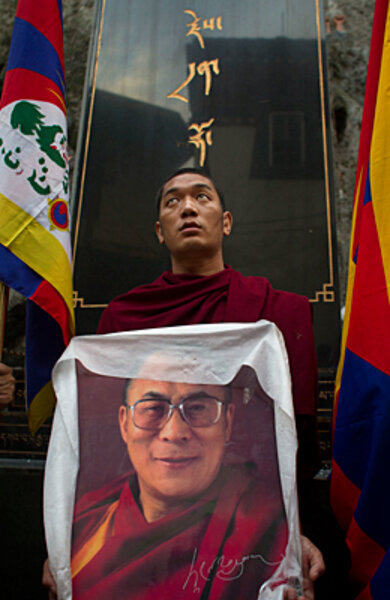In Tibet, defiant self-immolations spread beyond monks, nuns
Loading...
| Paris
While Chinese Olympic gold medals in London make headlines, far away, on the Himalayan roof of the world, two more young Tibetans – a mother and a monk – set themselves on fire in protest of Chinese policies on Tibet, including the lack of return of the Dalai Lama, the exiled spiritual leader.
The two “self-immolations” raise to 45 the number of Tibetans setting themselves alight, most since March of 2011. The immolations started with Buddhist monks and nuns who see themselves in an increasingly desperate struggle for the ancient land and its people, and who say their Tibetan identity and faith is being stamped out by aggressive Chinese policies and actions.
Yet 13 of the self-immolations in Tibet this year suggest that ordinary Tibetans are starting to torch themselves, and that the cases appear to be spreading geographically and are less confined to a few dissident monasteries.
“The self-immolations have now jumped a number of fences. There are more of them and they are more diverse,” says Steven Marshall, a member of the Congressional-Executive Commission on China in Washington, who had extensive experience in Tibet in the 1980s and 1990s. “We are seeing immolations in the lay community, not only among monks and nuns where it started. It is also spreading into a greater area, not just the [Tibet Autonomous Region], but Qinghai and Gansu [provinces abutting the Tibet Autonomous Region].”
Yesterday, a mother of two, Dolkar Tso, from a farming family, set herself alight at a monastery in Gansu Province, which abuts the Tibetan Autonomous Region. She died from the flames. The International Campaign for Tibet in London cited exile sources in a statement saying she called out for the return of the Dalai Lama and for freedom in Tibet, following a pattern in other cases.
On Monday, a young monk from the Kirti monastery, 21-year-old Lobsang Tsultrim, set himself on fire in the region of Ngaba in Sichuan Province. Exile reports say he was still alive when taken away by a police car. Lobsang is the 27th monk from the Ngaba area to self-immolate, and the eighth from the Kirti monastery. His act took place on a street that is alternately being called “Martyrs Road” or “Heroes Road."
Dalai Lama opposed self-immolation
While the Dalai Lama has consistently opposed self-immolations as a violation on the sacredness of life, Tibetans are continuing to do it in an act seen as indicative of the depth of feeling and desperation. Self-immolations are new and not part of any previous Tibetan protest tradition.
Tibetan Buddhist leaders have described the mood inside Tibet as a life and death struggle for the future of their faith and identity, and say that time is running out.
“They are calling for Dalai Lama’s return because they are in this very serious moment, very serious, in which the Tibetan nation, identity, culture, the spiritual tradition, are all being closed down by Chinese aggression,” says Kate Saunders, the spokeswoman for International Campaign for Tibet in London. “There is a very powerful feeling that time is running out, and that the connection between the people and what the Dalai Lama represents is being broken. These young people are sacrificing out of desperation that this spiritual connection not be broken. What they are calling out as they burn is for the return of the Dalai Lama, and for freedom in Tibet.”
A year ago today, the Dalai Lama stepped down as official head of the government in exile after decades, but retains preeminence as the spiritual leader of Tibetans. In Tibetan monasteries, China continues to oversee aspects of religious instruction, control the appointment of teachers, give patriotic loyalty tests -- actions that many Tibetans protest as serious infringements by Beijing on the faith.
Photos of the Dalai Lama in Tibet are forbidden.
“All monasteries must display pictures of Mao Zedong and Chinese President Hu Jintao and fly the Chinese flag. In numerous monasteries, forced patriotic reeducation campaigns are under way,” states Lobsang Sangay, who now heads a newly democratic government in exile in Dharamsala, India, in a statement this week. “Monks or nuns refusing to cooperate with Chinese policies are evicted from monasteries or arrested,” and in some cases nuns have been asked to stomp on the images of the Dalai Lama.
Some Tibetan experts say the past year of self-immolations represent a “tipping point” in the deepening clashes between locals and Chinese authorities. But a consensus is also developing that Tibetan anger and discontent is near full boil. Tibetan nationalism is on the rise, seen partly through videos capturing enormous crowds attending the funeral services of the immolators.
“We are past a tipping point … the situation has already tipped,” argues Mr. Marshall. “If lay Tibetans are now more prone to express less hope for the future, that is a problem for the [Chinese Communist] Party.”
Beijing authorities often equate support for the Dalai Lama as synonymous with “succession.” In recent months, they have vastly ramped up security forces in Tibet armed with fire extinguishers and “hooks” used to collar those who are trying to self-immolate. There is also a new and sophisticated Chinese media campaign. A multilingual, state-run CCTV series of broadcasts this summer on “The Dalai Clique and the Self-Immolation Events” essentially accuses the leader and other Buddhists of promoting the self-burnings, and includes on-the-ground graphic video footage and interviews with local Chinese police chiefs.
The region, meanwhile, is shut off from most foreign and Western journalists, NGOs, and human rights groups.








